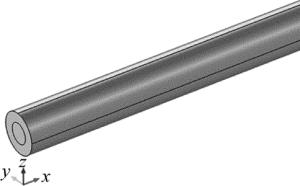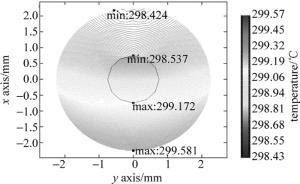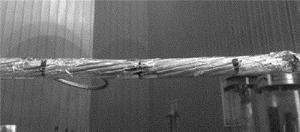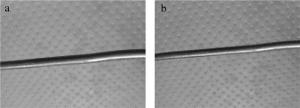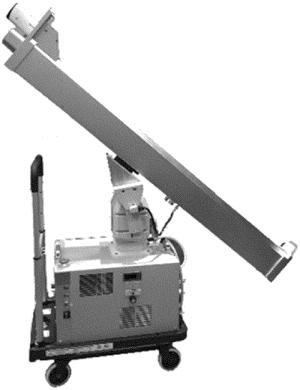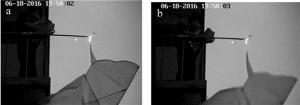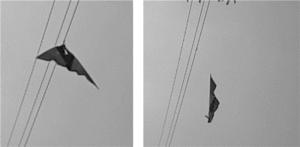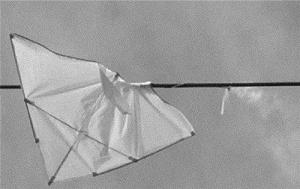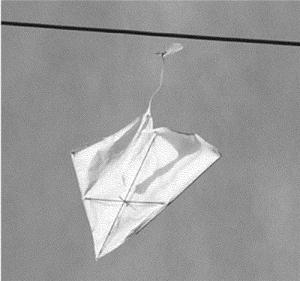-
架空输电线路点多面广、跨度大、线路长,沿线环境复杂,风筝和风筝线、农用塑料布、广告布、遮阳网等漂浮性异物经常缠挂在输电线路上,可造成相间短路、单相接地,导致线路跳闸停电或线路损毁,垂落的异物或烧断损毁的导线还可造成人畜伤亡,给电力系统和社会造成了极大的经济损失。以江苏省为例,江苏省现有输电线路19000多公里,每年发生异物挂线次数约1200次; 2012年统计显示,江苏省110kV~500kV因异物短路导致的跳闸事故85次,占所有跳闸事故的25.3%[1];由跳闸停电引起的直接经济损失,以110kV线路为例,假设平均每次事故停电1h,总的直接经济损失为:有功功率×功率系数×停电时间×单位电价×事故次数=33000kW×0.85×1.0h×0.505元×85≈120.4万元[2],220kV和500kV的线路跳闸停电的损失粗略估计分别为110kV线路的10倍和100倍以上,而由异常停电对社会造成的间接经济损失和负面影响更是难以估量。
目前,异物的清除作业主要采用一些传统方法和工具或稍加改进的工具进行清除。对于杆塔及杆塔附近导线上的异物,可通过作业人员攀登杆塔,手工摘除,或借助绝缘操作杆、绝缘异物清除杆等工具清除;对于高度、交通条件合适的异物,可采用绝缘斗臂车、登高车协助处理。位于档距中间、离杆塔较远、地形交通条件有限的异物,是清除难度较大、耗时较长、经常需要停电作业的异物,由于输电线路走廊中导线所占长度比重远大于杆塔,因此这种异物也是发生概率最高的一类,目前主要采用软梯、吊篮、翻斗滑车挂钩等工具和方法处理,具有需攀爬杆塔、走线、高电压高空作业、难度高、风险大、耗时长、需停电作业等缺点,耗费了大量人力物力,给电力系统线路巡检工作造成沉重的压力。
为解决异物清除效率以及作业人员安全等问题,一些新型的清除工具和方法相继出现,例如改进型的异物清除绝缘杆[3]、改进型绝缘绳工具[2, 4]、遥控放生操作工具[5],这些工具主要是对传统工具进行优化改造,在实际应用中相对于传统的工具,切实提高了清除效率,但尚未脱离传统工具的范畴,主要依靠人工作业;一些智能化、自动化创新型的工具及研究相继出现,但由于其自身的一些缺陷,没有能够大面积推广使用,例如,输电线爬行烧除机[6]通过遥控装置爬行到异物所在位置通过喷火烧除异物,需要作业人员攀爬杆塔,装置安放在导线上;无人机喷火装置[7]通过控制无人机飞到异物位置喷火烧除异物,功能性实验较多,但未充分研究确定安全性,包括火焰引起空气放电或短路、1000℃左右的高温火焰对导线的损伤[8-9]、操控不当坠机问题、异物所处位置等,到目前还没有得到推广应用。
针对上述问题,本文中提出基于陆基定向能激光的架空线路异物远程清除方法,通过从地面发射激光辐照高空异物,以“地对空”的方式将异物远程灼烧切割击落,从而实现远程、非接触式、可带电作业的异物清除方法,对于提高架空线路异物清除工作效率,降低维护成本,减轻作业人员工作强度和作业风险,提升输电系统可靠性,具有重要的意义。
-
激光清除异物时要求能够远程损毁异物而不损伤由铝、铝合金、钢等金属材料制成的导、地线,激光与材料相互作用主要与激光波长、功率密度、作用时间,以及材料的熔点、相变温度、热导率、比热容、材料表面对激光的吸收率等有关,架空线路上异物绝大部分是非金属材料的塑料和化纤制品,其热导率、熔点、燃点或软化温度远低于金属的(见表 1),需选择合适的激光器并采用合适的激光功率密度实现激光远程清除异物。
Table 1. Thermal properties of wire and some common foreign body material
material thermal conductivity/ (W·m-1· K-1) specific heat capacity/ (J·kg-1· K-1) melting point/ ignition point/ ℃ iron 80 450 1535 pure aluminum 237 910 660 aluminium alloy 100~237 ≈904 500~660 polyethylene 0.32~0.4 2301 < 200 polyvinyl chloride 0.12~0.17 1283~1464 < 200 polyester fiber 0.25 1340 250~270 nylon 0.15~0.50 1500~1930 < 390 rubber < 0.25 1700 350 相对于可见光和紫外波段激光,红外激光对金属表面吸收率较低,对人眼相对安全,传输时受大气气溶胶的吸收和散射比可见光和紫外光小很多[10],在空气中传输损耗和偏移量较小,而且红外激光器技术成熟,应用广泛,价格适中,适合作为异物激光清除系统光源。红外激光器中,考虑光束质量和效率,光纤激光器和CO2激光器是较好的选择,而CO2激光器目前成本相对较低,且对非金属材料作用效果更佳[11-12],适合未来大面积推广应用,本文中选择CO2激光器作为实验和设备的激光光源。
-
为确定激光用于清除异物的可行性,确定清除异物所需最合适的激光功率密度,采用图 1中的方法对常见异物材料[13-14]进行实验。激光功率100W,激光束在焦点后发散,在不同位置具有不同的光斑面积和相应的激光功率密度,将异物材料裁剪成10cm宽的样品,假定10s时间内能够烧穿异物,且40s内能够割断异物样品的功率密度为合格,从远及近放置和灼烧异物,记录每种异物切割合格的位置,并测量光斑尺寸,可计算得到该位置的功率密度。
通过对常用的风筝布料、风筝线、广告布、遮阳网、各种塑料布、气球、孔明灯等30余种常见异物的实验,计算确定采用CO2激光清除所有异物,所需的最小功率密度约为10W/cm2,工程应用中一般需保留一定裕度,采用2倍于最小功率密度(20W/cm2)的激光作为清除异物用激光(以下简称清异激光)。
-
利用激光清除异物的最大优势主要体现在对远离杆塔、高度较高的高电压等级导、地线异物清除方面,激光清除异物过程中难免辐照导线,作业过程中甚至需要沿导线辐照切割异物,高压线路导线一般采用钢芯铝绞线(aluminium conductors steel-reinforced,ACSR),外层为铝绞线,由于铝的电导率比钢的高很多,而且交流电在传输过程中存在趋肤效应,因此铝绞线起主要的导电作用,内部钢芯线主要起抗拉作用,钢芯容易腐蚀,故钢芯上一般镀锌或镀铝保护。由于清异激光功率密度较小,金属导线对10640nm激光吸收率较低,清异激光对钢芯铝绞线直接造成严重力学退化或高温熔断的可能性极小,本文中采用COMSL Multiphysics进行有限元仿真研究清异激光是否会造成导线涂镀层高温熔化损伤、铝线熔化断股。为便于仿真,不计芯线之间的空隙,认为材料各向同性,涂镀层在模型中不考虑,建立如图 2所示几何仿真模型[15-16]。
钢芯铝绞线规格众多,规格越小的导线热容和散热条件相对越差,激光辐照损伤可能性越大,本文中选用钢芯铝绞线中规格最低的LGJ-10/2作为研究对象,LGJ-10/2由6根1.5mm直径的铝线和1根1.5mm直径的钢芯线绞制而成,外径4.5mm,最大连续载流量87A。仿真中考虑导线载流温升、日照温升(1000W/m2,日照吸收率取为0.5)[16-17]、激光辐照热作用、金属热传导、自然对流散热、表面辐射散热,不考虑强制对流散热,金属铝对10640nm激光吸收率较低,室温下光滑铝表面对10640nm激光的吸收率为0.019[18],仿真中设定为较极端的数值0.9。
仿真结果如图 3所示。激光辐照导线时最高温度299.581℃远低于铝的熔点600℃,故不会熔化损伤铝绞线或镀铝层,钢芯线上的最高温度299.172℃远低于锌熔点420℃[19],未达到熔化损伤镀锌层的温度。实际情况下,导线对激光的吸收率远低于0.9,空气流动造成的强制对流散热会进一步降低温度,因此清异激光辐照钢芯铝绞线时的实际温度低于仿真温度,因而不会对导线有所损伤。
采用清异激光分别对钢芯铝绞线、铝绞线单丝进行辐照,图 4为钢芯铝绞线在20W/cm2功率密度激光辐照5min后的照片。在钢芯铝绞线的辐照点后部贴温度传感器,测得最高温度为130℃。图 5a为辐照前的导线图片; 图 5b为辐照后的导线图片。结果显示,钢芯铝绞线和单股铝线在清异激光辐照5min后均无损伤。
-
异物除缠绕导线外,还可能缠绕绝缘子、横担、塔架部分。绝缘子主要有复合绝缘子、玻璃绝缘子、陶瓷绝缘子,复合绝缘子采用有机复合材料制成,非常容易受到激光损伤,玻璃绝缘子和陶瓷绝缘子在清异激光的作用下也可能受到损伤[20-21];横担有铁、瓷、合成绝缘材料等,其中铁材质的可承受清异激光辐照,瓷和合成绝缘材料有受损可能;塔架一般由钢铁组成,可承受清异激光辐照。因此,对于绝缘子上的异物,若采用激光清除,应避免直射绝缘子,可调整光束方向,避开绝缘子切割清除异物,或采用传统上塔清除;对于横担上的异物,应根据其材质采用不同的清除方法;对于塔架上的异物,可直接用激光清除。
-
玻璃管CO2激光器技术成熟,成本远低于目前的CO2射频金属管激光器,适合大范围推广使用,因此,采用功率为100W的定制型玻璃管CO2激光器,光束质量M2≤1.1,全角发散角为3.5mrad,光斑直径5mm,激光管总长1.2m,直径80mm,重量约4kg;采用三镜片组合的光路结构,先扩束后聚焦,焦距可调,将光束整形,缩小远程光斑,使清异激光最远射程可达60m;由于10640nm激光不可见,采用绿激光与红外光合束输出,由绿激光指示红外光方向,如图 6所示。
所选激光管工作时总功耗约为500W,出光100W,发热量约400W,采用500W小型制冷冷水机对激光管进行冷却;供电系统采用锂电池组,容量2000W·h,可对整个系统供电约1h。采用30倍光学放大的可调焦长焦摄像机作远程瞄准观察;采用精密云台转向控制光束扫描,云台最小转动角度分辨率为0.01°。研制的异物清除设备如图 7所示。
-
为验证激光清除异物设备的功能和实用性,对研制的设备进行了远程异物清除模拟实验和现场工程应用。
-
将异物绑在金属棍子上,绑定在离地30m~40m的楼外侧,将激光清除异物设备指示光瞄准异物目标,开启激光并控制云台转动光束方向,远程切割清除异物。
图 8为农用塑料布的清除,农用塑料布一般较大,实验中采用沿线切割异物的方式,控制云台缓慢转动激光方向,成功割断异物使之掉落,整个过程耗时约2min。图 8a为近距离拍摄的清除过程图片; 图 8b为瞄准摄像机中录下的图像,是作业人员在操作过程中所看到的图像;图 8c为异物被远程切割后掉落一瞬间的图片; 图 8d为清除掉落的异物样品。
图 9为风筝清除实验。风筝是架空线路上最常见的异物之一,大部分风筝挂线是由于风筝线、尾巴等缠绕导线,清除时只需灼烧缠绕部分即可,图 9a为瞄准异物时的图片; 图 9b为击落异物瞬间,耗时约1s。
-
2016年4月,激光清除异物设备在江苏常州进行了现场消缺。常州35kV岱丰3541线上缠挂大型风筝一只,挂线位置位于十字交叉路口处,距离地面约20m,现场车流量大,交通繁忙,采用激光清异设备,在不影响现场交通,不停电状态下,对异物进行远程清除,将绿激光对准风筝线缠绕导线位置,开启激光后约10s将异物清除掉落,如图 10所示。
2016年6月,江苏南京某220kV线路缠挂白色风筝一只,该异物远离杆塔,距离地面约40m,异物下方车辆无法到达,按照传统方法只能采用滑梯、吊篮或翻斗滑车挂钩等工具,花费时间30min~60min才能清除该异物。采用激光异物清除设备,发射激光远程灼烧异物缠挂部位如图 11所示,该过程仅耗时约1min就将异物成功击落。图 12为缠挂部位烧毁后异物掉落的一瞬间。
-
利用20W/cm2的CO2激光可远程清除高空异物,对导线无损伤。实验和工程应用证明,激光清除异物设备可方便、快速、安全地清除架空线路异物,大幅度提高异物清除效率,减少异物清除工作耗费的人力和物力资源,减少高空作业和高压作业,降低作业难度和风险,提高工作人员工作安全性,减少生产安全责任事故,提高异物清除及时性,降低异物导致的电力事故发生率。该技术是激光技术在电力系统的一项重要创新应用,对于提升电力系统的安全性和可靠性具有重要的意义。
架空线路异物激光清除技术研究
Study on laser removal technology of foreign bodies on overhead transmission lines
-
摘要: 为了解决传统工具和方法难以经济、高效、安全地清除架空输电线路异物的问题,提出了陆基定向能红外激光远程切割清除架空线路异物的方法,并进行了理论分析、有限元仿真和实验验证。基于上述研究,研制了架空线路异物激光清除设备,并进行了模拟实验和现场工程应用。结果表明,清除异物所需最小功率密度为20W/cm2,该功率密度的激光对导线不会造成损伤。该设备可远程、快速、带电、安全地清除架空线路异物。Abstract: In order to solve the problem that the traditional tools and methods can not meet the requirement of clearing foreign object debris economically, efficiently and safely, the method of clearing foreign object debris on overhead power lines with land-based directed energy laser remotely was proposed. Theoretical analysis, finite element simulation and experimental verification were carried out. Based on the above research, the apparatus for removing foreign bodies from overhead lines by laser was developed, tested and applied in engineering practice. The result shows that the appropriate minimum power density is 20W/cm2, and the laser irradiation of 20W/cm2 is unable to damage the wire. The laser removal apparatus can remove foreign bodies on overhead lines under live working conditions efficiently and safely at long distance.
-
Table 1. Thermal properties of wire and some common foreign body material
material thermal conductivity/ (W·m-1· K-1) specific heat capacity/ (J·kg-1· K-1) melting point/ ignition point/ ℃ iron 80 450 1535 pure aluminum 237 910 660 aluminium alloy 100~237 ≈904 500~660 polyethylene 0.32~0.4 2301 < 200 polyvinyl chloride 0.12~0.17 1283~1464 < 200 polyester fiber 0.25 1340 250~270 nylon 0.15~0.50 1500~1930 < 390 rubber < 0.25 1700 350 -
[1] WANG Ch Y. Treatment method of foreign objects on grounding conductor for transmission line[J].Qinghai Electric Power, 2014, 33(1):20-22(in Chinese). [2] LIU M L, YANG H F. Easy to remove floating debris leads the development and application tools[J]. Automation Panorama, 2011(s2):185-187(in Chinese). [3] XU Q. A Multi-function device and application for extra matter dis- posal for transmission lines[J]. Jiangsu Electrical Engineering, 2015, 34(5):15-16(in Chinese). [4] LU D, XIA Zh Q, TANG X M, et al. An improved method and the tool development for live-working demolish of unidentified objects on transmission lines[J]. Zhejiang Electric Power, 2015(11):24-27(in Chinese). [5] ZHANG Zh J, SUN W, FU Zh C. The use of remote bionic operation tool removing foreign bodies in distribution line[J]. Power & Energy, 2012, 33(4):340-343(in Chinese). [6] ZHAO H B, MA X Y. Introduction to remotely controlled burning-off machine for cleaning the foreign matter wrapped on transmission Lines[J]. Sci-Tech Information Development & Economy, 2011, 21(33):194-197(in Chinese). [7] ZHU D Zh, LIU J W, LIANG H J, et al. Development of apparatus for removing foreign bodies based on remote control fire vehicle[J].China Science & Technology Panorama Magazine, 2016(10):49-50(in Chinese). [8] KIM S D, MORCOS M M. Mechanical deterioration of ACSR conductors due to forest fires[J]. IEEE Transastions on Power Delivery, 2003, 18(1):271-276. doi: 10.1109/TPWRD.2002.804011 [9] WANG Zh H, YOU F, ZHANG Y, et al. Analyses on damage behaviors and mechanism of operation properties of typical high-voltage transmission line under intense heat and blaze[J]. Fire Science and Technology, 2015, 34(6):714-718(in Chinese). [10] LAN X J. Laser technology[M].Beijing:Science Press, 1995:239-255(in Chinese). [11] READY J F. Industrial applications of lasers[M]. London, UK:Academic Press, 1997:320-330. [12] READY J F. LIA handbook of laser materials processing[M]. Orlando, USA:Laser Institute of America, 2001:182. [13] LIANG W, CHEN J, LIU Y, et al. A new device for removing foreign matter from overhead lines and its experimental study[J]. China Electric Power(Technology Edition), 2015(9):57-59(in Chinese). [14] LI H Z, CHENG G, LIU Y, et al.The study of laser ablative characteristics of typical wire and foreign body on overhead line[J].High Voltage Engineering, 2015, 41(s1):107-111(in Chinese). [15] HE Zh J, LI Zh B, LIANG P W. ANSYS calculation method of temperature and current-carrying capacity for transmission lines[J]. Zhejiang Electric Power, 2010, 29(8):1-5(in Chinese). [16] HE Y J, ZHU R H, SHEN Zh H, et al. Numerical simulation of laser-induced transient temperature field in cylindrical shell[J]. Laser Technology, 2005, 29(4):386-388(in Chinese). [17] LIU Y F. Study on the current-temperature thermal circuit model of overhead line based on parameter identify[D]. Nanjing: Nanjing University of Science and Technology, 2015: 8-22(in Chinese). [18] ZHANG G Sh. Modern laser manufacturing technology[M].Beijing:Chemical Industry Press, 2006:23-29(in Chinese). [19] REN Zh J, XUE G X. Practical handbook of metallic materials[M]. Nanjing:Jiangsu Science and Technology Press, 2007:1039(in Chinese). [20] JIAO J K, WANG X B, LU H. Analysis of temperature field and thermal stress field in quartz glass heated by laser beams[J]. Laser Technology, 2007, 31(4):427-430(in Chinese). [21] QI L J. Laser deicing theoretical and experimental research for transmission lines[D]. Wuhan: Huazhong University of Science and Technology, 2012: 79-94(in Chinese). -


 网站地图
网站地图


 下载:
下载:
